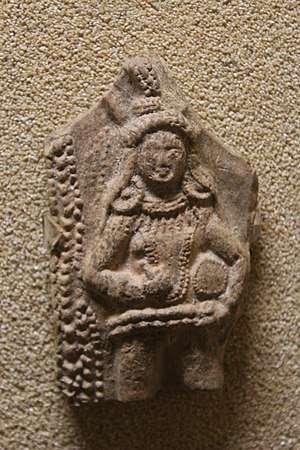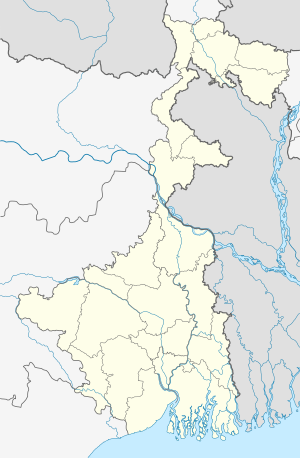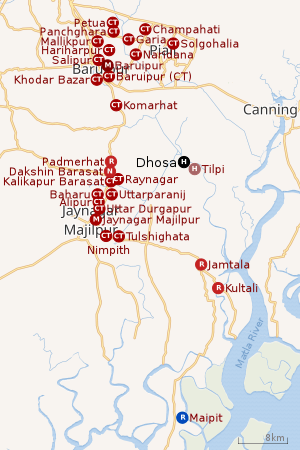Dhosa, Jaynagar
Dhosa is a village, a gram panchayat and an archaeological site within the jurisdiction of the Jaynagar police station in the Jaynagar I CD block in the Baruipur subdivision of the South 24 Parganas district in the Indian state of West Bengal.
Dhosa | |
|---|---|
Village | |
 Terracotta Plaque Found at Dhosa/Tilpi, Now at State Archaeological Museum at Behala | |
 Dhosa Location in West Bengal  Dhosa Location in India | |
| Coordinates: 22.2469°N 88.5469°E | |
| Country | |
| State | West Bengal |
| District | South 24 Parganas |
| CD Block | Jaynagar I |
| Area | |
| • Total | 2.34 km2 (0.90 sq mi) |
| Elevation | 8 m (26 ft) |
| Population (2011) | |
| • Total | 2,401 |
| • Density | 1,000/km2 (2,700/sq mi) |
| Languages | |
| • Official | Bengali[1][2] |
| • Additional official | English[1] |
| Time zone | UTC+5:30 (IST) |
| PIN | 743396 |
| Telephone code | +91 3218 |
| Vehicle registration | WB-19 to WB-22, WB-95 to WB-99 |
| Lok Sabha constituency | Jadavpur |
| Vidhan Sabha constituency | Baruipur Purba (SC) |
| Website | www |
History
According to the District Census Handbook, this archeological site is located beside the Piyali river. The artefacts found at this place included “fine terracotta pottery, seals, plaques, jewellery of precious and semi-precious stones, figurines, ceramic earthen wares etc.” [3]
According to Sharmi Chakraborty, Centre for Archaeological Studies and Training, Eastern India, the site was excavated by the Directorate of Archaeology and Museums. They found the remains to begin in around 1st century CE. Amongst the artefacts recovered were a terracotta plaque of Yaksi, and ram and elephant figurines.[4]
Geography
 |
| Cities and towns in the southern part of Baruipur subdivision (including Baruipur, Jaynagar I & II, Kultali CD blocks) in South 24 Parganas district M: municipal city/ town, CT: census town, R: rural/ urban centre, N: neighbourhood, H: historical place/ religious centre Places linked with coastal activity are marked in blue Owing to space constraints in the small map, the actual locations in a larger map may vary slightly |
Area overview
Baruipur subdivision is a rural subdivision with moderate levels of urbanization. 31.05% of the population lives in the urban areas and 68.95% lives in the rural areas. In the southern portion of the subdivision (shown in the map alongside) there are 20 census towns. The entire district is situated in the Ganges Delta and the southern part is covered by the Baruipur-Jaynagar Plain.[5][6][7]
Note: The map alongside presents some of the notable locations in the subdivision. All places marked in the map are linked in the larger full screen map.
Location
Dhosa is located at 22.2469°N 88.5469°E. It has an average elevation of 8 metres (26 ft).
Demographics
According to the 2011 Census of India, Dhosa had a total population of 2,401, of which 1,216 (51%) were males and 1,185 (49%) were females. There were 316 persons in the age range of 0 to 6 years. The total number of literate persons in Dhosa was 1,285 (61.63% of the population over 6 years).[8]
Transport
Gocharan-Dhosa Road links Dhosa to the State Highway 1.[9]
Gocharan railway station is located nearby.[9]
Education
Dhosa Chandaneswar Nabin Chand Higher Secondary School has around 3,000 students.[10]
Healthcare
Padmerhat Rural Hospital, with 30 beds, at Padmerhat, is the major government medical facility in the Jaynagar I CD block.[11]
References
- "Fact and Figures". Wb.gov.in. Retrieved 5 July 2019.
- "52nd REPORT OF THE COMMISSIONER FOR LINGUISTIC MINORITIES IN INDIA" (PDF). Nclm.nic.in. Ministry of Minority Affairs. p. 85. Archived from the original (PDF) on 25 May 2017. Retrieved 5 July 2019.
- "District Census Handbook South Twentyfour Parganas, Census of India 2011, Series 20, Part XII A" (PDF). Pages 134-135: Places of Archaeological Importance. Directorate of Census Operations, West Bengal. Retrieved 3 January 2020.
- Chakraborty, Sharmi. "Archaeological Sites of Lower Deltaic Region of West Bengal and Their Context: Some Preliminary Observations". Academia.edu. Retrieved 3 January 2020.
- "District Statistical Handbook 2014 South Twety-four Parganas". Table 2.1 , 2.2, 2.4b. Department of Statistics and Programme Implementation, Government of West Bengal. Retrieved 5 December 2019.
- "Census of India 2011, West Bengal, District Census Handbook, South Twentyfour Parganas, Series – 20, Part XII-A, Village and Town Directory" (PDF). Page 13, Physiography. Directorate of Census Operations, West Bengal. Retrieved 5 December 2019.
- "District Human Development Report: South 24 Parganas". Chapter 9: Sundarbans and the Remote Islanders, p 290-311. Development & Planning Department, Government of West Bengal, 2009. Archived from the original on 5 October 2016. Retrieved 5 December 2019.
- "C.D. Block Wise Primary Census Abstract Data(PCA)". West Bengal – District-wise CD Blocks. Registrar General and Census Commissioner, India. Retrieved 3 January 2020.
- Google maps
- "Dhosa Chandaneswar Nabin Chand Higher Secondary School". Heyschools. Retrieved 3 January 2020.
- "Health & Family Welfare Department" (PDF). Health Statistics – Rural Hospitals. Government of West Bengal. Retrieved 29 November 2019.
External links
| Wikimedia Commons has media related to Jaynagar Majilpur. |